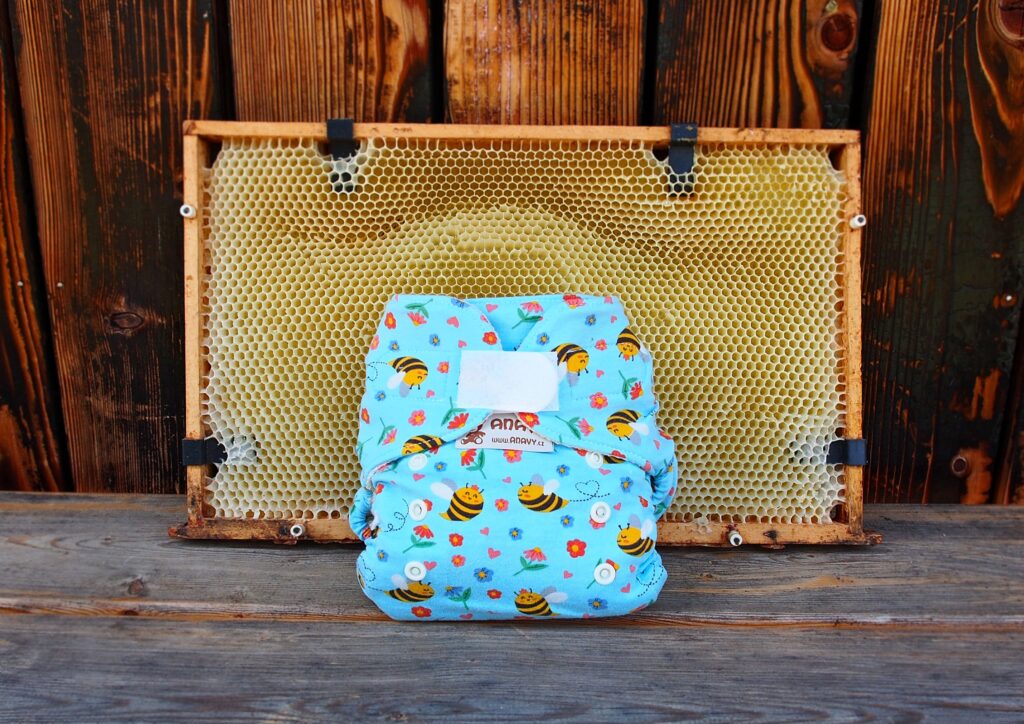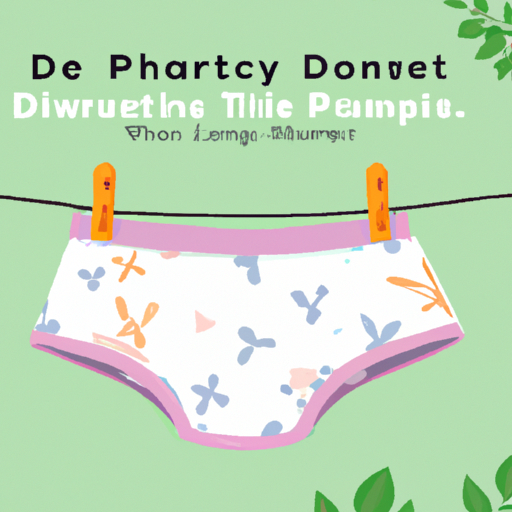In this article, you will learn all about cloth diapers – the benefits they offer and how to use them. We will explore why cloth diapering is becoming increasingly popular and discuss the advantages it brings for both your baby and the environment. Additionally, we will provide you with practical tips and step-by-step instructions on how to successfully navigate the world of cloth diapering. By the end, you will have a comprehensive understanding of cloth diapers and the knowledge to make an informed decision for you and your family.

What are cloth diapers?
Definition of cloth diapers
Cloth diapers are reusable alternatives to disposables that are made from various absorbent materials such as cotton, bamboo, or hemp. They are designed to be washed and reused multiple times, reducing waste and environmental impact.
Types of cloth diapers
There are several types of cloth diapers available in the market, each with its own advantages and suitability for different situations. Some common types include:
-
Prefold diapers: These are rectangular diapers that require folding and securing with pins or snappies. They are versatile and can be used with waterproof covers.
-
Flat diapers: Similar to prefold diapers, flat diapers are rectangular in shape but do not have any specific folds. They can be folded in various ways for customized absorbency.
-
Fitted diapers: Fitted diapers are contoured diapers that have elastic at the waist and legs for a snug fit. They usually require a waterproof cover.
-
Pocket diapers: Pocket diapers consist of a waterproof outer layer and an inner pocket where absorbent inserts can be placed. They are easy to use and convenient for quick changes.
-
All-in-one diapers: All-in-one diapers are designed to be the most similar to disposable diapers. They have an absorbent layer sewn into the diaper, eliminating the need for inserts or additional covers.
-
Hybrid diapers: Hybrid diapers combine the benefits of cloth and disposable diapers. They have a reusable outer cover and the option to use either a cloth or disposable insert.
Each type of cloth diaper has its own pros and cons, so it’s important to consider your lifestyle, budget, and personal preferences when choosing the right cloth diaper for your baby.
Benefits of using cloth diapers
Environmental benefits
One of the primary reasons parents choose cloth diapers is for their positive impact on the environment. Disposable diapers contribute to a significant amount of waste in landfills, taking hundreds of years to decompose. By using cloth diapers, you can greatly reduce your carbon footprint and help protect the planet for future generations.
Cost-saving benefits
Another advantage of cloth diapers is the potential for long-term cost savings. While the initial investment may be higher compared to disposable diapers, using cloth diapers can save you a considerable amount of money in the long run. Disposable diapers need to be purchased continuously, while cloth diapers can be reused for multiple children or resold after your baby has outgrown them.
Health benefits
Cloth diapers are often touted as being healthier for babies compared to disposables. They are typically made from natural fibers that are gentle on a baby’s sensitive skin. Cloth diapers allow for better airflow, reducing the likelihood of diaper rash and other skin irritations. Additionally, cloth diapers do not contain potentially harmful chemicals or fragrances that can be found in some disposable diapers.
Reduced diaper rash
One of the most common concerns for parents is diaper rash. Cloth diapers, particularly those made from natural fibers, can help prevent and reduce the occurrence of diaper rash. The breathable materials and absence of chemicals or fragrances in cloth diapers allow the baby’s skin to breathe, keeping it dry and reducing the chances of irritation.

How to choose the right cloth diaper
Considerations for fit
When choosing a cloth diaper, it’s important to consider the fit for optimal comfort and leak protection. Look for diapers that have adjustable closures, such as snaps or hook-and-loop fasteners, so you can customize the fit to your baby’s size and shape. Additionally, elasticized legs and waistbands help create a secure fit and prevent leaks.
Understanding absorbency
Absorbency is a crucial factor in choosing the right cloth diaper. Different fabrics have varying levels of absorbency, so it’s important to consider your baby’s needs. If you have a heavy wetter or need longer periods of time between diaper changes, opt for diapers made from highly absorbent materials such as bamboo or hemp.
Closure options
Cloth diapers come with different closure options, each with its own advantages. Snaps are durable and secure, but they may require additional steps for adjustment. Hook-and-loop fasteners, also known as Velcro, provide a more customizable fit but may wear out over time. Consider your preferences and ease of use when deciding on the closure type.
Material choices
Cloth diapers are available in a variety of materials, each with its own benefits. Common materials include:
- Cotton: Cotton is a popular choice for its softness, breathability, and absorbency. It is easy to care for and readily available.
- Bamboo: Bamboo is a highly absorbent and antimicrobial fabric, making it an excellent choice for cloth diapers. It is also sustainable and eco-friendly.
- Hemp: Hemp is known for its durability and absorbency. It is a great option for heavy wetters or overnight use.
- Microfiber: Microfiber is a synthetic material that is highly absorbent, but it can be prone to compression leaks. It is often used in inserts rather than the inner layer of diapers.
Consider the pros and cons of each material and how they align with your priorities when making a decision.
How to properly care for cloth diapers
Pre-washing instructions
Before using cloth diapers for the first time, it’s important to pre-wash them to remove any chemicals or residues from the manufacturing process. Follow the manufacturer’s instructions for pre-washing, which usually involves washing the diapers multiple times with detergent and drying them between washes.
Washing and drying routines
Establishing a washing and drying routine is essential for maintaining the cleanliness and longevity of your cloth diapers. Here are a few guidelines to follow:
- Frequency: Aim to wash cloth diapers every two to three days to prevent odors and bacterial growth.
- Pre-rinse: Start the washing process with a cold water pre-rinse to remove any excess waste or urine.
- Main wash: Wash the diapers in hot water with a recommended amount of detergent. Avoid using fabric softeners, bleach, or additives that can affect absorbency or cause buildup.
- Drying: Line drying cloth diapers is the most environmentally friendly option. However, if that is not possible, tumble drying on low heat or using an air-dry setting is also acceptable.
Dealing with stains
Stains are a common occurrence with cloth diapers, but they can be treated effectively. Here are a few methods to tackle stains:
- Sunning: Place stained diapers in direct sunlight. The ultraviolet rays naturally bleach and sanitize the fabric.
- Stain removers: There are numerous cloth diaper-safe stain removers available in the market. Follow the instructions provided by the manufacturer for the best results.
- Diaper liners: Using diaper liners can help prevent stains from setting in as they provide a barrier between the diaper and waste.

Common misconceptions about cloth diapers
Cloth diapers are difficult to use
Contrary to popular belief, cloth diapers are not as complicated as they may seem. Modern cloth diapers are designed to be user-friendly and straightforward. Once you establish a routine and understand the basics, cloth diapering becomes second nature.
Cloth diapers are unhygienic
Some people worry about the hygiene aspect of cloth diapers, but when properly cared for and washed, cloth diapers are just as hygienic as disposables. Following the recommended washing and drying routines will ensure that your cloth diapers are clean and safe for your baby.
Cloth diapers leak more often
While it’s true that cloth diapers may require a bit more attention to fit and absorbency, leaks can be easily prevented by choosing the right diaper, ensuring proper fit, and using sufficient absorbent material. With proper care and attention to detail, cloth diapers can be just as leak-proof as disposables.
Tips for using cloth diapers on-the-go
Packing essentials for outings
When using cloth diapers on-the-go, it’s essential to be prepared. Some key items to pack include:
- Extra diapers: Pack an ample supply of cloth diapers for the duration of your outing. The number will depend on how long you’ll be out and how frequently your baby typically needs diaper changes.
- Wet bag: A wet bag is a waterproof bag designed to hold soiled diapers. It keeps odors and moisture contained until you can wash them at home.
- Diaper cream: Some diaper creams may not be compatible with cloth diapers, so be sure to choose a cloth diaper-friendly option or use a diaper liner to protect the fabric.
Using diaper liners or inserts
Diaper liners or inserts can be a helpful addition when using cloth diapers on-the-go. Liners create a barrier between your baby’s skin and the diaper, making cleanup easier. Simply remove the liner and dispose of it in a trash bin. Inserts can provide an extra layer of absorbency for longer outings or heavy wetters.
Proper disposal of dirty diapers
When disposing of dirty cloth diapers while away from home, it’s important to have a plan in place. A common method is to carry a wet bag or a sealable container specifically for soiled diapers. This prevents odors and leakage until you can wash the diapers at home.

How to troubleshoot common issues with cloth diapers
Diaper leaks
Diaper leaks can occur for several reasons, such as improper fit, insufficient absorbency, or compression leaks. Here are some troubleshooting tips:
- Check fit: Ensure that the diaper is snug around the legs and waist without being too tight. Adjust the closures or snaps as necessary.
- Boost absorbency: If leaks occur due to insufficient absorbency, consider adding an extra insert or trying a different material that holds more liquid.
- Reactivate fabric: Over time, the absorbency of fabric may decrease. Strip your diapers by washing them with a small amount of dish soap and rinse until no suds remain.
Diaper rashes
Diaper rashes can happen with both disposable and cloth diapers, but they can be managed effectively. Here are a few tips:
- Change diapers frequently: Wetness and bacteria can contribute to diaper rashes. Change your baby’s diapers regularly to keep them dry and clean.
- Use cloth-friendly creams: Some diaper creams may not be compatible with cloth diapers as they can leave residue and affect absorbency. Look for cloth diaper-safe creams or use a liner between the cream and the diaper.
- Allow for air circulation: Give your baby’s bottom some diaper-free time to allow the skin to breathe and heal.
Odor control
If you notice persistent odors coming from your cloth diapers, there are steps you can take to address the issue:
- Proper cleaning routine: Ensure that you are following a thorough washing and drying routine. Bacteria and detergent buildup can contribute to odors.
- Stripping diapers: If odors persist, stripping your diapers by washing them several times without detergent or using a specialized stripping agent can help remove any residual odor-causing substances.
How to transition from disposable to cloth diapers
Gradual transition approach
Transitioning from disposable to cloth diapers can be done gradually if you find it more manageable. Start by using cloth diapers during the day and disposables at night or during outings. As you become more comfortable, gradually increase the use of cloth diapers until you make a complete switch.
Troubleshooting challenges
During the transition period, you may encounter some challenges, such as leaks or fit issues. Address these challenges by adjusting the fit, adding extra inserts, or trying different materials. Research common troubleshooting techniques and reach out to cloth diapering communities for support and advice.
Creating a routine
Creating a routine can help streamline the cloth diapering process. Establish a regular schedule for washing, drying, and airing out diapers. It may take some trial and error to find a routine that works best for you and your family, but consistency will make the transition easier.

Cloth diaper accessories and additional resources
Diaper pail options
When using cloth diapers, it’s important to have a designated place for storing dirty diapers before washing. Some popular options include:
- Wet pail: A wet pail is a container filled with water and a diaper-safe solution to soak diapers before washing. This method is less commonly used today due to the risk of bacterial growth and potential hazards for children.
- Dry pail: A dry pail involves storing dirty diapers without water. Use a lidded diaper pail or a large wet bag to contain odor and moisture.
Cloth diapering accessories
There are several accessories available that can enhance your cloth diapering experience:
- Diaper sprayer: A diaper sprayer attaches to your toilet and allows you to spray off solid waste directly into the toilet, minimizing the mess and making cleanup easier.
- Cloth wipes: Cloth wipes are reusable alternatives to disposable wipes. They can be used alongside cloth diapers and are often more gentle on a baby’s skin.
- Diaper liners: Diaper liners create a barrier between the baby’s skin and the diaper. They make cleanup easier by catching solid waste, which can be flushed down the toilet or disposed of separately.
Online communities and support groups
Engaging with online communities and support groups can be invaluable for cloth diapering parents. These communities offer a wealth of knowledge, tips, and advice from experienced cloth diaper users. Joining these groups can provide a sense of community, as well as support throughout your cloth diapering journey.
Conclusion
Cloth diapers offer numerous benefits, including environmental sustainability, cost savings, and potential health benefits for your baby. By understanding the different types of cloth diapers, selecting the right fit and absorbency, and following a proper care routine, cloth diapering can be a rewarding and enjoyable experience. Do not be discouraged by common misconceptions or challenges along the way. With the right resources and support, you can successfully transition to cloth diapers and provide a comfortable and eco-friendly diapering option for your little one.





